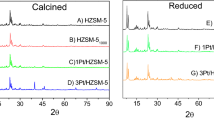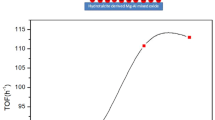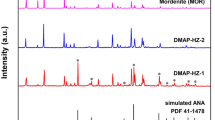Abstract
In this work, we developed a novel strategy in which catalytic processes are suitable for the selective hydrogenation of benzaldehyde under visible light illumination. It was intended to compare the catalytic activities and to optimize the benzaldehyde hydrogenation reaction with Pd-based catalysts on different support groups (activated carbon, alumina, clinoptilolite). It was also determined that the use of immobilized Pd0 on amine-functionalized clinoptilolite (CLI) could enhance the selectivity toward benzyl alcohol (BA) in the hydrogenation of benzaldehyde (BAld). These prepared catalysts were characterized by using different analysis techniques, including XRD, BET surface area analysis, FTIR, and TGA analysis for determining the total surface acidity and SEM analysis. The final product concentrations were determined in gas chromatography (GC). Catalytic reactions were carried out under both temperature effects and halogen lamp irradiation as a novel method for comparison with the conventional hydrogenation technique. The best catalytic performance was obtained at 2Pd/APTMSCLI with total conversion and 100% BA selectivity. This work provides a novel approach for the development of a new bifunctional hydrogenation catalyst and may have a significant impact on the advancement of technology to obtain BA with high efficiencies.













Similar content being viewed by others
References
Bhanushali JT, Kainthla I, Keri RS, Nagaraja BM (2016) Catalytic hydrogenation of benzaldehyde for selective synthesis of benzyl alcohol: a review. ChemistrySelect 1:3839–3853. https://doi.org/10.1002/slct.201600712
Hao Y, Pischetola C, Cárdenas-Lizana F, Keane MA (2020) Selective liquid phase hydrogenation of benzaldehyde to benzyl alcohol over alumina supported gold. Catal Lett 150:881–887. https://doi.org/10.1007/s10562-019-02944-y
Cheng G, Jentys A, Gutiérrez OY et al (2021) Critical role of solvent-modulated hydrogen-binding strength in the catalytic hydrogenation of benzaldehyde on palladium. Nat Catal 4:976–985. https://doi.org/10.1038/s41929-021-00701-2
Sadou M, Saadi A, Bachari K et al (2018) MCM-41 Supported copper-based catalysts: physicochemical characterizations and catalytic performances in the gas phase hydrogenation of benzaldehyde. J Bio- Tribo-Corrosion 4:1–10. https://doi.org/10.1007/s40735-018-0177-5
Das PP, Chowdhury B (2020) Indium oxide nanoparticles embedded in TUD-1 as a highly selective catalyst for toluene to benzaldehyde oxidation using TBHP as oxidant. Chem Pap 74:2091–2100. https://doi.org/10.1007/s11696-020-01054-z
Singh N, Sanyal U, Ruehl G et al (2020) Aqueous phase catalytic and electrocatalytic hydrogenation of phenol and benzaldehyde over platinum group metals. J Catal 382:372–384. https://doi.org/10.1016/j.jcat.2019.12.034
Kong X, Chen L (2014) Hydrogenation of aromatic aldehydes to aromatic hydrocarbons over Cu-HZSM-5 catalyst. Catal Commun 57:45–49. https://doi.org/10.1016/j.catcom.2014.07.038
Zhang Y, Zhou J, Li K, Lv M (2020) Synergistic catalysis of hybrid nano-structure Pd catalyst for highly efficient catalytic selective hydrogenation of benzaldehyde. Catal Today 358:129–137. https://doi.org/10.1016/j.cattod.2020.01.022
Derle SN, Parikh PA (2014) Hydrogenation of levulinic acid and γ-valerolactone: steps towards biofuels. Biomass Convers Biorefinery 4:293–299. https://doi.org/10.1007/s13399-013-0111-5
Sreenavya A, Ganesh V, Venkatesha NJ, Sakthivel A (2022) Hydrogenation of biomass derived furfural using Ru-Ni-Mg–Al-hydrotalcite material. Biomass Convers Biorefinery. https://doi.org/10.1007/s13399-022-02641-8
Ajellal N, Carpentier JF, Guillaume C et al (2010) Metal-catalyzed immortal ring-opening polymerization of lactones, lactides and cyclic carbonates. Dalt Trans 39:8363–8376. https://doi.org/10.1039/c001226b
Yang B, Burch R, Hardacre C et al (2013) Influence of surface structures, subsurface carbon and hydrogen, and surface alloying on the activity and selectivity of acetylene hydrogenation on Pd surfaces: a density functional theory study. J Catal 305:264–276. https://doi.org/10.1016/j.jcat.2013.05.027
Sheldon JC, Bowie JH, Dua S et al (1997) The gas-phase Cannizzaro disproportionation reactions of benzaldehyde and pivaldehyde. J Org Chem 62:3931–3937. https://doi.org/10.1021/jo9520598
Yuk SF, Lee MS, Akhade SA, et al (2020) First-principle investigation on catalytic hydrogenation of benzaldehyde over Pt-group metals. Catal Today 1–8. https://doi.org/10.1016/j.cattod.2020.07.039
Perret N, Cárdenas-Lizana F, Keane MA (2011) Selective hydrogenation of benzaldehyde to benzyl alcohol over Au/Al 2O3. Catal Commun 16:159–164. https://doi.org/10.1016/j.catcom.2011.09.017
Wen J, Jiang J, Zhang X (2016) Rhodium-catalyzed asymmetric hydrogenation of α, β-unsaturated carbonyl compounds via thiourea hydrogen bonding. Org Lett 18:4451–4453. https://doi.org/10.1021/acs.orglett.6b01812
Dupont J, Fonseca GS, Umpierre AP et al (2002) Transition-metal nanoparticles in imidazolium ionic liquids: recycable catalysts for biphasic hydrogenation reactions. J Am Chem Soc 124:4228–4229. https://doi.org/10.1021/ja025818u
Radkevich VZ, Senko TL, Wilson K et al (2008) The influence of surface functionalization of activated carbon on palladium dispersion and catalytic activity in hydrogen oxidation. Appl Catal A Gen 335:241–251. https://doi.org/10.1016/j.apcata.2007.11.029
Choi EY, Nam IS, Kim YG (1996) TPD study of mordenite-type zeolites for selective catalytic reduction of NO by NH3. J Catal 161:597–604. https://doi.org/10.1006/jcat.1996.0222
Rahkamaa-Tolonen K, Maunula T, Lomma M et al (2005) The effect of NO2 on the activity of fresh and aged zeolite catalysts in the NH3-SCR reaction. Catal Today 100:217–222. https://doi.org/10.1016/j.cattod.2004.09.056
Van Donk S, Janssen AH, Bitter JH, De Jong KP (2003) Generation, characterization, and impact of mesopores in zeolite catalysts. Catal Rev - Sci Eng 45:297–319. https://doi.org/10.1081/CR-120023908
Zhao Z, Li Y, Feyen M et al (2018) Pd nanoparticles encapsulated in FER zeolite through a layer reassembling strategy as shape-selective hydrogenation catalyst. ChemCatChem 10:2254–2259. https://doi.org/10.1002/cctc.201800040
Krishnarao RV, Subrahmanyam J (2003) Studies on the formation of TiB2 through carbothermal reduction of TiO2 and B2O3. Mater Sci Eng A 362:145–151. https://doi.org/10.1016/S0921-5093(03)00523-9
Gao F, Li Y, Bian Z et al (2015) Dynamic hydrophobic hindrance effect of zeolite@zeolitic imidazolate framework composites for CO2 capture in the presence of water. J Mater Chem A 3:8091–8097. https://doi.org/10.1039/c4ta06645f
Wang X, Li H, Liu H, Hou X (2011) AS-synthesized mesoporous silica MSU-1 modified with tetraethylenepentamine for CO2 adsorption. Microporous Mesoporous Mater 142:564–569. https://doi.org/10.1016/j.micromeso.2010.12.047
Harlick PJE, Sayari A (2007) Applications of pore-expanded mesoporous silica. 5. triamine grafted material with exceptional CO2 dynamic and equilibrium adsorption performance. Ind Eng Chem Res 46:446–458. https://doi.org/10.1021/ie060774+
Nik OG, Chen XY, Kaliaguine S (2011) Amine-functionalized zeolite FAU/EMT-polyimide mixed matrix membranes for CO2/CH4 separation. J Memb Sci 379:468–478. https://doi.org/10.1016/j.memsci.2011.06.019
Ma X, Wang X, Song C (2009) “Molecular basket” sorbents for separation of CO 2 and H 2S from various gas streams. J Am Chem Soc 131:5777–5783. https://doi.org/10.1021/ja8074105
Wingenfelder U, Nowack B, Furrer G, Schulin R (2005) Adsorption of Pb and Cd by amine-modified zeolite. Water Res 39:3287–3297. https://doi.org/10.1016/j.watres.2005.05.017
Soylu GSP, Özçelik Z, Bozismail, (2010) Total oxidation of toluene over metal oxides supported on a natural clinoptilolite-type zeolite. Chem Eng J 162:380–387. https://doi.org/10.1016/j.cej.2010.05.020
Pozan GS, Boz I (2006) Catalytic hydrodechlorination of 2,4-dichlorophenol on Pd/Rh/C catalysts. J Hazard Mater 136:917–921. https://doi.org/10.1016/j.jhazmat.2006.01.030
Pozan GS (2012) Effect of support on the catalytic activity of manganese oxide catalyts for toluene combustion. J Hazard Mater 221–222:124–130. https://doi.org/10.1016/j.jhazmat.2012.04.022
Abusafa A, Yücel H (2002) Removal of 137Cs from aqueous solutions using different cationic forms of a natural zeolite: clinoptilolite. Sep Purif Technol 28:103–116. https://doi.org/10.1016/S1383-5866(02)00042-4
Dimowa L, Tzvetanova Y (2021) Powder xrd study of changes of cd2+ modified clinoptilolite at different stages of the ion exchange process. Minerals 11. https://doi.org/10.3390/min11101130
Arkhireeva A, Hay JN, Oware W (2005) A versatile route to silsesquioxane nanoparticles from organically modified silane precursors. J Non Cryst Solids 351:1688–1695. https://doi.org/10.1016/j.jnoncrysol.2005.04.063
Rostami M, Mohseni M, Ranjbar Z (2011) Investigating the effect of pH on the surface chemistry of an amino silane treated nano silica. Pigment Resin Technol 40:363–373. https://doi.org/10.1108/03699421111180509
Piscitelli F, Posocco P, Toth R et al (2010) Sodium montmorillonite silylation: Unexpected effect of the aminosilane chain length. J Colloid Interface Sci 351:108–115. https://doi.org/10.1016/j.jcis.2010.07.059
Hanim SAM, Malek NANN, Ibrahim Z (2016) Amine-functionalized, silver-exchanged zeolite NaY: preparation, characterization and antibacterial activity. Appl Surf Sci 360:121–130. https://doi.org/10.1016/j.apsusc.2015.11.010
López-Fonseca R, Aranzabal A, Gutiérrez-Ortiz JI et al (2001) Comparative study of the oxidative decomposition of trichloroethylene over H-type zeolites under dry and humid conditions. Appl Catal B Environ 30:303–313. https://doi.org/10.1016/S0926-3373(00)00244-7
Ravi M, Sushkevich VL, van Bokhoven JA (2021) On the location of Lewis acidic aluminum in zeolite mordenite and the role of framework-associated aluminum in mediating the switch between Brønsted and Lewis acidity. Chem Sci 12:4094–4103. https://doi.org/10.1039/d0sc06130a
Arai M, Obata A, Nishiyama Y (1997) The influence of reduction methods and conditions on the activity of alumina-supported platinum catalysts for the liquid phase hydrogenation of benzaldehyde in ethanol. J Catal 166:115–117. https://doi.org/10.1006/jcat.1997.1514
Han M, Zhang H, Du Y et al (2011) Catalytic hydrogenation of benzaldehydes over platinum nanoparticles immobilized on magnesium aluminate spinel under mild conditions. React Kinet Mech Catal 102:393–404. https://doi.org/10.1007/s11144-010-0266-z
Koh K, Sanyal U, Lee M et al (2020) Electrochemically tunable proton-coupled electron transfer in Pd-catalyzed benzaldehyde hydrogenation. Angew Chemie 132:1517–1521. https://doi.org/10.1002/ange.201912241
Guo XF, Jang DY, Jang HG, Kim GJ (2012) Hydrogenation and dehydrogenation reactions catalyzed by CNTs supported palladium catalysts. Catal Today 186:109–114. https://doi.org/10.1016/j.cattod.2011.11.001
Proto A, Cucciniello R, Genga A, Capacchione C (2015) A study on the catalytic hydrogenation of aldehydes using mayenite as active support for palladium. Catal Commun 68:41–45. https://doi.org/10.1016/j.catcom.2015.04.028
Shirai M, Sato O, Hiyoshi N, Yamaguchi A (2014) Enhancement of reaction rates for catalytic benzaldehyde hydrogenation and sorbitol dehydration in water solvent by addition of carbon dioxide. J Chem Sci 126:395–401. https://doi.org/10.1007/s12039-014-0582-3
Okamoto M, Hirao T, Yamaai T (2010) Polymers as novel modifiers for supported metal catalyst in hydrogenation of benzaldehydes. J Catal 276:423–428. https://doi.org/10.1016/j.jcat.2010.10.008
Mironenko RM, Belskaya OB, Gulyaeva TI et al (2017) Liquid-phase hydrogenation of benzaldehyde over Pd-Ru/C catalysts: synergistic effect between supported metals. Catal Today 279:2–9. https://doi.org/10.1016/j.cattod.2016.07.022
Zhang W, Shi W, Ji W et al (2020) Microenvironment of MOF channel coordination with Pt NPs for selective hydrogenation of unsaturated aldehydes. ACS Catal 10:5805–5813. https://doi.org/10.1021/acscatal.0c00682
Xu YM, Bin ZW, Hu YM et al (2020) The effects of MoOx decoration on the selective hydrogenation of crotonaldehyde over MoOx-promoted Ir/TUD-1 catalysts. J Catal 381:222–233. https://doi.org/10.1016/j.jcat.2019.11.007
Pischetola C, Ruiz-Ruiz A, Cárdenas-Lizana F (2021) Continuous production of benzylideneacetophenone via gas phase reaction of benzaldehyde and acetophenone: mechanism and reaction kinetics. Chem Eng J 418. https://doi.org/10.1016/j.cej.2021.129306
Haffad D, Kameswari U, Bettahar MM et al (1997) Reduction of benzaldehyde on metal oxides. J Catal 92:85–92
Samec JSM, Bäckvall JE, Andersson PG, Brandt P (2006) Mechanistic aspects of transition metal-catalyzed hydrogen transfer reactions. Chem Soc Rev 35:237–248. https://doi.org/10.1039/b515269k
Linic S, Aslam U, Boerigter C, Morabito M (2015) Photochemical transformations on plasmonic metal nanoparticles. Nat Mater 14:567–576. https://doi.org/10.1038/nmat4281
Shih YH, Hsu CY, Su YF (2011) Reduction of hexachlorobenzene by nanoscale zero-valent iron: kinetics, pH effect, and degradation mechanism. Sep Purif Technol 76:268–274. https://doi.org/10.1016/j.seppur.2010.10.015
Lopez-Ruiz JA, Sanyal U, Egbert J et al (2018) Kinetic investigation of the sustainable electrocatalytic hydrogenation of benzaldehyde on Pd/C: effect of electrolyte composition and half-cell potentials. ACS Sustain Chem Eng 6:16073–16085. https://doi.org/10.1021/acssuschemeng.8b02637
Malacea R, Poli R, Manoury E (2010) Asymmetric hydrosilylation, transfer hydrogenation and hydrogenation of ketones catalyzed by iridium complexes. Coord Chem Rev 254:729–752. https://doi.org/10.1016/j.ccr.2009.09.033
Saadi A, Rassoul Z, Bettahar MM (2006) Reduction of benzaldehyde on alkaline earth metal oxides. J Mol Catal A Chem 258:59–67. https://doi.org/10.1016/j.molcata.2006.05.029
Lucas SJ, Crossley BD, Pettman AJ et al (2013) A robust method to heterogenise and recycle group 9 catalysts. Chem Commun 49:5562–5564. https://doi.org/10.1039/c3cc42550a
Hu G, Huang ZP, Hu CX et al (2020) Selective Photocatalytic hydrogenation of α, β-unsaturated aldehydes on Au/CuCo2O4 nanotubes under visible-light irradiation. ACS Sustain Chem Eng 8:8288–8294. https://doi.org/10.1021/acssuschemeng.0c01852
Pinna F, Menegazzo F, Signoretto M et al (2001) Consecutive hydrogenation of benzaldehyde over Pd catalysts - influence of supports and sulfur poisoning. Appl Catal A Gen 219:195–200. https://doi.org/10.1016/S0926-860X(01)00685-8
Acknowledgements
The authors would like to sincerely express their thanks to the Scientific Research Projects (BAP) Coordination Unit of Istanbul University-Cerrahpaşa for supporting the project under project no.: 59742 and project ID.: 3690.
Funding
The Scientific Research Projects Coordination Unit of Istanbul University-Cerrahpaşa supported the project under project no.: 59742 and project ID.: 3690.
Author information
Authors and Affiliations
Contributions
Conceptualization: Gulin Selda Pozan Soylu; methodology: Gulin Selda Pozan Soylu and Yasar Zengin; formal analysis and investigation: Yasar Zengin; writing—original draft preparation: Yasar Zengin and Gulin Selda Pozan Soylu; writing—review and editing: Yasar Zengin and Gulin Selda Pozan Soylu; resources: Yasar Zengin; supervision: Gulin Selda Pozan Soylu.
Gulin Selda Pozan Soylu conceived the idea and designed the experiments. Yasar Zengin conducted the material synthesis and characterization experiments, carried out the major catalytic performance test, and wrote the manuscript.
Corresponding author
Ethics declarations
Ethics approval and consent to participate
This article does not contain any studies with human participants or animals performed by any of the authors.
Conflict of interest
The authors declare no competing interests.
Additional information
Publisher's note
Springer Nature remains neutral with regard to jurisdictional claims in published maps and institutional affiliations.
Supplementary Information
Below is the link to the electronic supplementary material.
Rights and permissions
Springer Nature or its licensor (e.g. a society or other partner) holds exclusive rights to this article under a publishing agreement with the author(s) or other rightsholder(s); author self-archiving of the accepted manuscript version of this article is solely governed by the terms of such publishing agreement and applicable law.
About this article
Cite this article
Zengin, Y., Soylu, G.S.P. The synthesis of benzyl alcohol: process optimization, photo-illuminated liquid phase hydrogenation, the improved green catalysts from natural zeolite. Biomass Conv. Bioref. 14, 10533–10547 (2024). https://doi.org/10.1007/s13399-022-03637-0
Received:
Revised:
Accepted:
Published:
Issue Date:
DOI: https://doi.org/10.1007/s13399-022-03637-0




